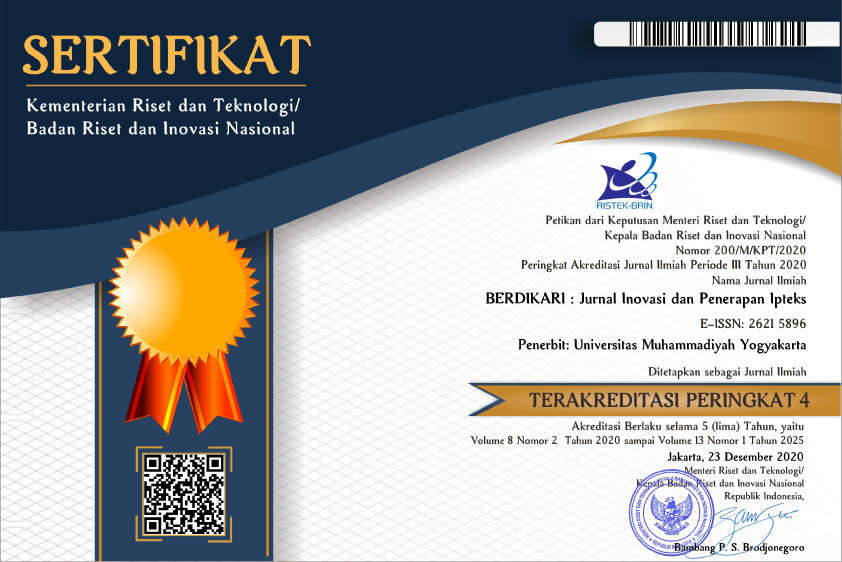Pembelajaran Engineering Design Process untuk Memperkenalkan Proses Pembelajaran Abad 21 pada Siswa Madrasah Ibtidaiyah Raudhatul Qur’an
DOI:
https://doi.org/10.18196/berdikari.v9i2.10779Keywords:
children, engineering design, drawing, Tech for Kids, learning modelAbstract
From age two, children strive to be more independent, and they also need encouragement to make simple choices in their lives. The level of independence of children must be following their ages, abilities, and activities. Since children’s education through over-regulation is inappropriate, we should encourage them to draw and make games instead. Children need to learn to plan their activities so that they can develop their creativity. Based on that background, community service programs by introducing Tech for Kids are necessary. This method focused on learning the Engineering Design Process, which is a 21st Century learning model. This program aimed to introduce children to the design process. Design is the study of the aesthetics and uses of things in everyday life. However, professional designers sometimes have a complex multi-step process for creating and improving plans to solve problems. Engineering design is a user-centered design process. The process starts with ethnography to produce a prototype as a solution concept that suits the community’s needs. The methods applied in the implementation of the service program are tutorials and mentoring practices. The results of the community service program show that social and cross-cultural knowledge and skills in children or students increase with indicators of presentation of work results as confirmed by the results of the skill test, which increased from level 1 to 3.References
Abdullah, M., & Osman, K. (2010). 21st Century Inventive Thinking Skills Among Primary Students In Malaysia And Brunei, Procedia - Social and Behavioral Sciences, 9, 1646-1651. DOI : https://doi.org/10.1016/j.sbspro.2010.12.380
Izquierdo, M. E., & Kruse, E., S. (2016). Image Analysis for 3D Modeling, Rendering, and Virtual View Generation, Computer Vision and Image Understanding, 71(2), 231-253. DOI : https://doi.org/10.1006/cviu.1998.0706
Lai, J. W.M., & Bower, M. (2019). How is the use of technology in education evaluated? A systematic review, Computers & Education, 133, 27-42. DOI : https://doi.org/10.1016/j.compedu.2019.01.010
Madrasah Ibtidaiyah Raudhatul Qur’an Gg. Kano, Air Raja, Kec. Tanjungpinang Tim., Kota Tanjung Pinang, Kepulauan Riau 29125, https://maps.app.goo.gl/1FyEQSRZQ6pjScjT9, diunduh pada Tuesday, 27 October 2020 20:00
Mayhew, P. J., Worsley, C., J, & Dearnley, P., A. (1989). Information and Software Technology, 31(2), 59-66. DOI : https://doi.org/10.1016/0950-5849(89)90084-0
Pokojski, J., Oleksiński, K., & Pruszyńsk, J. (2019). Conceptual And Detailed Design Knowledge Management In Customized Production – Industrial Perspective, Journal of Computational Design and Engineering, 6(4), 479-506. DOI : https://doi.org/10.1016/j.jcde.2019.02.004
Siew, NM, Goh, H, Sulaiman, F, 2016. Integrating Stem In An Engineering Design Process: The Learning Experience Of Rural Secondary School Students In An Outreach Challenge Program, Journal of Baltic Science Education, 15(4), 477–493.
Unina, N., & Bearing, P. (2016). Brainstorming as a Way to Approach Student-centered Learning in the ESL Classroom , Procedia - Social and Behavioral Sciences, 224, 605-612. DOI : https://doi.org/10.1016/j.sbspro.2016.05.450
Widodo, Kamaediani, D. R., & Aini, L. R. (2016). Kewirausahaan Jamur Tiram Di Pondok Pesantren, Jurnal Berdikari, 4(1), 23-30. DOI : https://doi.org/10.18196/bdr.413
Widodo, N., & Nugroho, S. (2019). Peningkatan Pemahaman Kurikulum 2013 bagi Guru Sekolah Jurnal Berdikari, 7(2), 171-186. DOI : https://doi.org/10.18196/bdr.7270
Widyastuti, T., & Astuti, R. J. (2016). Penataan Halaman Sekolah Sebagai Ekoedukasi. Jurnal Berdikari, 4(1), 54-62. DOI : https://doi.org/10.18196/bdr.416
Downloads
Additional Files
Published
Issue
Section
License
Copyright
Authors retain copyright and grant BERDIKARI Jurnal Inovasi dan Penerapan IPTEK the right of first publication with the work simultaneously licensed under an Attribution 4.0 International (CC BY 4.0) that allows others to remix, adapt and build upon the work with an acknowledgment of the work's authorship and of the initial publication in BERDIKARI Jurnal Inovasi dan Penerapan IPTEK.
Authors are permitted to copy and redistribute the journal's published version of the work (e.g., post it to an institutional repository or publish it in a book), with an acknowledgment of its initial publication in BERDIKARI Jurnal Inovasi dan Penerapan IPTEK
License
Articles published in the BERDIKARI Jurnal Inovasi dan Penerapan IPTEK) are licensed under an Attribution 4.0 International (CC BY 4.0) license. You are free to:
- Share — copy and redistribute the material in any medium or format.
- Adapt — remix, transform, and build upon the material for any purpose, even commercially.
This license is acceptable for Free Cultural Works. The licensor cannot revoke these freedoms as long as you follow the license terms. Under the following terms:
- Attribution — You must give appropriate credit, provide a link to the license, and indicate if changes were made. You may do so in any reasonable manner, but not in any way that suggests the licensor endorses you or your use.
- No additional restrictions — You may not apply legal terms or technological measures that legally restrict others from doing anything the license permits.




